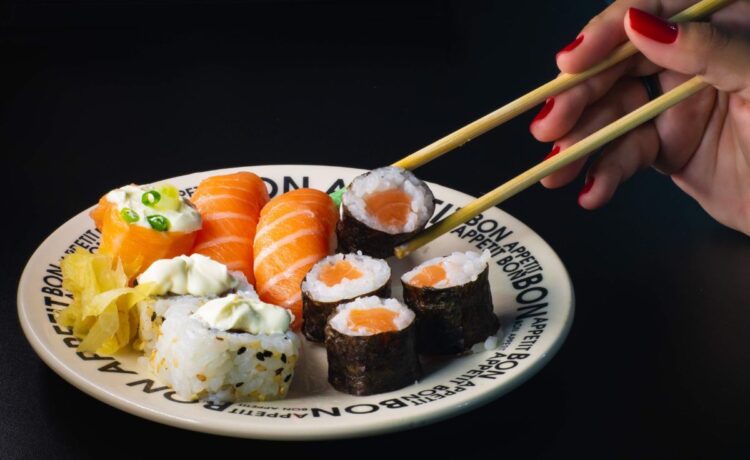In recent years, veggie sushi rolls have grown in popularity, and for good reason. They not only offer a tasty and energizing substitute for standard sushi rolls, but they also have a number of health advantages. Vegetable sushi rolls are a great alternative whether you’re a vegetarian, trying to increase the amount of plant-based foods in your diet, or just want to try something new. In this post, we’ll examine the nutritional worth of vegetable sushi rolls, learn about their calorie composition, and even provide you with a mouthwatering recipe to make at home.
Table of Contents
Health Benefits of Veggie Sushi Rolls

The numerous health benefits of vegetarian sushi rolls are one of its key features. These rolls offer a multitude of vitamins, minerals, and antioxidants since they are filled with fresh veggies and other healthy components. Vegetable sushi rolls are a great option for weight control since the veggies used are often low in calories and high in fiber. Additionally, seaweed, which is a high source of iodine and is necessary for thyroid health, is frequently used to make these rolls.
Vegetable sushi rolls are also a fantastic source of plant-based protein. These rolls are a filling and healthy dinner alternative since tofu, tempeh, and edamame are frequently added as sources of protein. Additionally, the addition of ginger and wasabi to vegetable sushi rolls has a number of health advantages. Wasabi contains antibacterial qualities and can help to strengthen your immune system, while ginger provides anti-inflammatory and digestive benefits.
Understanding the Calorie Content of Veggie Sushi Rolls
Vegetarian sushi rolls’ calorie counts might change based on the products used and their portion proportions. Vegetarian sushi rolls often have less calories than their meat- or fish-based counterparts. The rice used to produce vegetarian sushi rolls is the main source of calories in them. However, you may lower the total calorie count of these rolls by using less rice and adding more vegetable fillings.
| Content | Qty |
|---|---|
| 1.) Calories : | 224 |
| 2.) Total fat : | 5 g |
| Saturated fat : | 1 g |
| Trans fat : | 0 g |
| 3.) Cholesterol : | 0 mg |
| 4.) Sodium : | 508.6 mg |
| 5.) Total carbs: | 42 g |
| Dietary fiber : | 4.1 g |
| Sugar : | 9 g |
| 6.) Protein : | 4 g |
It’s significant to remember that how the vegetarian sushi rolls are prepared also affects how many calories they contain. Deep-fried rolls and rolls cooked with a lot of mayonnaise or other high-calorie sauces will naturally contain more calories. You may reduce your calorie intake and yet enjoy the mouth watering flavors of vegetable sushi rolls by choosing rolls that are gently steamed, baked, or cooked with healthy sauces.

Nutritional Value of Veggie Sushi Rolls
Vegetable sushi rolls are low in calories and loaded with vital vitamins and minerals. These vegetable rolls include a variety of vitamins and minerals, including potassium, vitamin C, vitamin K, and folate. These vitamins and minerals are essential for sustaining a strong immune system, promoting bone health, and controlling blood pressure.
Vegetable sushi rolls are also a fantastic fiber source. Fiber is a great supplement to any weight loss diet since it aids in digestion and encourages feelings of fullness. Iodine, which is essential for healthy thyroid function, is significantly provided by the seaweed used in vegetarian sushi rolls. Additionally, the plant-based protein in these rolls helps keep you fuller for extended periods of time in addition to being good for muscle building and repair.
Deliciously Fresh Veggie Sushi Rolls Recipe

It’s time to give preparing your own vegetarian sushi rolls a go now that you are aware of the nutritional worth and health advantages of these dishes. You can make your own vegan sushi rolls with the help of this mouthwateringly simple recipe.
Ingredients:
- 2 cups of sushi rice
- 4 nori seaweed sheets
- 1 cucumber, julienned
- 1 avocado, thinly sliced
- 1 carrot, julienned
- 1/2 cup of tofu, sliced into strips
- 1 bell pepper, thinly sliced
- Soy sauce and wasabi for serving
Instructions:
- Sushi rice should be prepared per the directions on the package, then allowed to cool.
- A bamboo sushi mat should have a sheet of nori seaweed on it.
- Leave approximately an inch of space at the top and evenly distribute a thin layer of sushi rice over the nori.
- Place the tofu, avocado, bell pepper, carrot, and so on in a line across the rice.
- Roll the nori sheet firmly using the sushi mat, using light pressure to create a compact roll.
- Apply the remaining materials and repeat the procedure.
- Slice the rolls into bite-sized pieces using a sharp knife.
- Wasabi and soy sauce are complimentary.

Tips for Making the Perfect Veggie Sushi Rolls
To ensure your veggie sushi rolls turn out perfectly every time, here are a few tips to keep in mind:
- For the finest flavor, use high-quality, freshly harvested ingredients.
- Before handling the sushi rice, wet your hands to avoid it sticking.
- Slice the rolls with a sharp knife, cleaning them clean after each cut to ensure straight edges.
- Try out various veggie pairings and sauces to make your own special rolls.
- Don’t give up if your first try isn’t flawless; practice makes perfect. You’ll soon master the art of sushi rolling if you persevere.
Variations and Creative Twists on Veggie Sushi Rolls
Even while the standard vegetarian sushi rolls are delectable on their own, there are a plethora of innovative modifications and additions you may try. Here are some suggestions to spark your culinary imagination:
- Sweet Potato Tempura Rolls: Add some crispy sweet potato tempura to your veggie sushi rolls for a delightful crunch.
- Mango Avocado Rolls: Combine the creaminess of avocado with the sweetness of ripe mango for a tropical twist.
- Spicy Peanut Rolls: Drizzle some spicy peanut sauce over your veggie sushi rolls to add a kick of flavor.
- Rainbow Rolls: Incorporate a spectrum of colorful vegetables, such as red bell pepper, yellow squash, and purple cabbage, to create visually stunning rolls.

Frequently Asked Questions – FAQs
Are veggie sushi rolls vegan?
Veggie sushi rolls can be vegan if they are made without any animal-derived ingredients. However, some traditional sushi ingredients, such as certain types of seaweed or sauces, may contain animal products, so it’s always best to check with the restaurant or sushi chef to ensure the rolls are vegan.
How are veggie sushi rolls different from other types of sushi rolls?
Veggie sushi rolls differ from other sushi rolls primarily in the absence of fish or seafood. Instead, they focus on using a variety of vegetables, making them suitable for vegetarians and vegans. Veggie rolls often have a lighter and fresher taste compared to rolls with fish or meat.
What vegetables are commonly used in veggie sushi rolls?
Common vegetables used in veggie sushi rolls include avocado, cucumber, carrot, bell pepper, radish, asparagus, sweet potato, and green leafy vegetables like spinach. The choice of vegetables can vary depending on personal preferences and regional variations.
What sauces are commonly used with veggie sushi rolls?
Veggie sushi rolls differ from other sushi rolls primarily in the absence of fish or seafood. Instead, they focus on using a variety of vegetables, making them suitable for vegetarians and vegans. Veggie rolls often have a lighter and fresher taste compared to rolls with fish or meat.
Conclusion
In addition to being a delicious and light supper alternative, veggie sushi rolls provide a number of health advantages. These rolls are a wholesome complement to any diet because of their wealth of vitamins, minerals, fiber, and plant-based protein. You may assist your health objectives by choosing wisely if you are aware of the calories and nutritional worth of vegetable sushi rolls. So why not give our simple and delicious recipe a try and make your own vegetarian sushi rolls? Get inventive, try out various fillings, and savor the delicious flavors of this vegan sushi alternative.

Read More Interesting Article
Your Ticket to Freedom: Places to Travel Without Passport
Best Time to Visit Canada: Top 10 Places for Memorable Vacations
Best Cities to Visit Australia: Discovering the Best Food, Culture, and Adventure
Italy Travel: Places to visit and tips for Exploring Italy’s hidden treasures
Japan Travel: Your Ultimate Travel Guide to Must-Visit Places and Best Time to Go
Top 10 Best Countries to Travel in 2023
10 Best Places for Free Dispersed Camping Colorado
10 Amazing Campgrounds – “Beach Camping Florida”
Top 10 Amazing Campgrounds – “Beach Camping California”
Top 10 Amazing Campgrounds – “Camping Oregon Coast”
Source and References for all the Image and videos are:
Photo by Kasumi Loffler – [Image]
Photo by Maria Camila Lopez – [Image]





